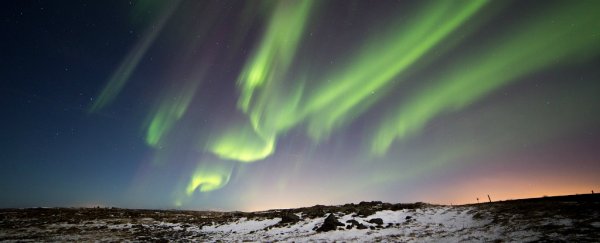NASA researchers have found evidence that suggests that aurorae - better known as the northern or southern lights - move in response to changes in Earth's magnetic field.
While understanding what causes these majestic lights to dance through the skies is something that researchers have been studying for decades now, the new findings might also shed light on how Earth's magnetosphere works, and how it might affect satellites and incoming solar winds.
"The space environment of our entire Solar System, both near Earth and far beyond Pluto, is determined by the Sun's activity, which cycles and fluctuates through time," NASA officials explain.
"The Solar System is filled with solar wind, the constant flow of charged particles from the Sun. Most of the solar wind is deflected from Earth by our planet's protective magnetosphere."
Before we dive into the new findings, let's do a quick refresher on aurorae, and specifically substorms.
Aurorae occur when solar particles hit Earth's magnetosphere - a region of space surrounding astronomical objects that's filled with charged particles controlled by a magnetic field.
This triggers magnetic disruptions called substorms, which cause the electrons trapped in the magnetosphere to interact with oxygen and nitrogen molecules.
"In this unstable environment, electrons in near-Earth space stream rapidly down magnetic field lines towards Earth's poles," the team explains. "There, they interact with oxygen and nitrogen particles in the upper atmosphere, releasing photons to create swathes of light that snake across the sky."
The most important part of a substorm - to understand these new findings, anyway - occurs when the magnetic field of the incoming solar winds turns southward, causing Earth's magnetic field to contract inward.
With this contraction, the back end of the magnetosphere - appropriately called the magnetotail - stretches, eventually snapping back in place like a rubber band, and this triggers an aurora.
Here's what that looks like:

Though these aurorae are known to vibrate back and forth and fluctuate in brightness, the link between magnetic field lines and aurora movement has largely been a mystery.
Now, that mystery might have been solved, because NASA researchers have found a way to map the dance of the aurorae to see how their brightness is dictated by the vibration of Earth's magnetic field lines.
 Emmanuel Masongsong/UCLA EPSS/NASA
Emmanuel Masongsong/UCLA EPSS/NASA
To create the map, the researchers used ground-based magnetic sensors in Canada and Greenland to see how electrical currents changed during a substorm.
They then coupled this information with data collected from five different probes called THEMIS - Time History of Events and Macroscale Interactions during Substorms – which are satellites orbiting Earth that line up every four days to study its magnetic field lines.
When they compared the two data sets, the team found that the dimming and brightening of the aurora, along with its wavy movement, was synced with the vibration of the magnetic field lines - a cycle that happened every 6 minutes.
"We were delighted to see such a strong match," said team leader Evgeny Panov, from the Space Research Institute of the Austrian Academy of Sciences in Austria.
"These observations reveal the missing link in the conversion of magnetic energy to particle energy that powers the aurora."
The team says that scientists previously thought that aurorae were guided by magnetic lines. Now, thanks to the THEMIS probes, they have evidence to support this hypothesis.
With further study, the team hopes to tease out even more details about how aurorae and the magnetosphere operate together, to hopefully understand the mechanisms that protect Earth from solar winds and particles.
The team's findings were published in Nature Physics.
